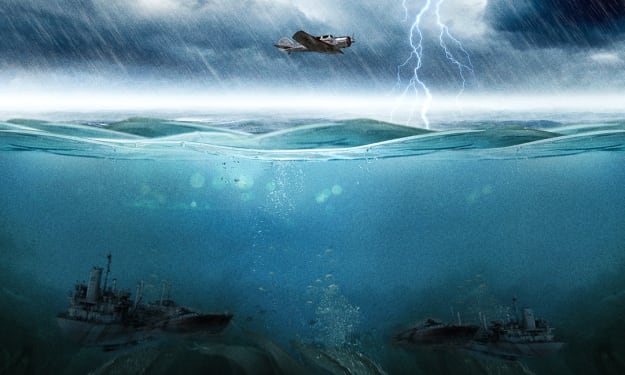Why Aliens Might Love Their Frozen Home
Why Aliens Might Love Their Frozen Home

Ever since astronomers discovered worlds beyond Earth, they’ve been trying to find life on them. And most were willing to bet that they’d find it on planets that look like Earth. You know, rocky with liquid water flowing on the surface. Not too hot, not too cold. Goldilocks conditions. And all those frozen-over worlds out there? Eh, those’ll be big wastelands.
But scientists are learning that icy environments might actually have benefits for some forms of life. In fact, some researchers now think that life might even thrive on icy worlds… not in spite of the ice, but because of it.
One perk of ice is that it can form a shield against dangerous radiation. Radiation is a catch-all term for things like light and high-energy particles that move energy from one place to another. And there’s a bunch of it in space, coming from extreme sources like supernovas and neutron star mergers, but also regular ol’ stars like our Sun. Some radiation is fine and dandy.
Your basic visible sunlight helps warm the Earth and is used by plants to make their own food. But the super energetic stuff is bad news. Those particles can barrel through a lot of materials and damage molecules like DNA, or in the case of other worlds, prevent the building blocks of life from ever forming.
Here on Earth, we’re pretty safe from this destructive radiation. Our planet has a magnetic field that deflects most of it, and the atmosphere absorbs many of the particles that manage to slip through. But not all worlds have a magnetic field, or a respectable atmosphere. In places like these, harmful radiation could make life all but impossible… unless they had some other kind of shield. And that’s why some astronomers are interested in ice. Like our atmosphere, ice is really good at absorbing radiation.
For example, Jupiter’s moon Europa has an ocean covered by an ice shell that’s between 15 to 25 kilometers thick. And scientists found that all that high-energy radiation coming from space would only penetrate, like, 20 centimeters of the stuff, max. So it’s safe to say life as we know it would be plenty protected, at least from that particular threat. Granted, that might not seem like an ideal habitat. But here on Earth, we have found microbes surviving under kilometers of Antarctic ice. They surround themselves in a kind of antifreeze mucus to keep from freezing solid, and subsist on nutrients that flow through pores in the ice.
It’s not exactly a glamorous lifestyle, but on a world without an atmosphere or magnetic field, life under an ice sheet might be as good as it gets. And if you’re wondering if NASA has plans to hunt for signs of life beneath the Europan ice, the answer is…yes! The Europa Clipper mission is currently scheduled to launch in 2024. Meanwhile, the European Space Agency has already launched Juice, which originally got its name from the acronym JUpiter ICy moons Explorer. Europa will be the first icy moon it visits.
We’ve just gotta wait until 2032. But if you’re hoping for a mission to the Europan surface… or under the surface… well, there’s nothing official in the pipeline just yet. In the meantime, some scientists have begun wondering if extraterrestrial life could actually exist within the ice on distant worlds. Not just under it, but inside it. That’s because it actually happens here on Earth. Scientists made this discovery in the Sea of Japan, where there are whole sheets of a type of ice called methane hydrate. It looks like regular ice, but if you could zoom in and see its crystal structure, you’d see a bunch of methane mixed in amongst the water molecules. In the Sea of Japan, it forms near vents on the seafloor that pump out methane. As the water freezes, it traps some of this methane within it. And if methane hydrate forms quickly enough, little bubbles of oil and saltwater… and even microbes… can get trapped inside too. Yep. Tiny little lifeforms.
Back in 2015, a team of scientists were doing some routine experiments on this ice, and were completely shocked to find organisms just chilling out and living off the oil. They had made a whole miniature habitat out of the bubbles between the molecules of an ice crystal. Beyond Earth, methane hydrates and other icy blends may exist on all kinds of rocky bodies, including comets, moons, and planets. And if this ice can host life on Earth, maybe it could host life on other worlds, too. So, ice can support life living below it and within it. But in some cases, it might also be the key to supporting life above it. On Earth, our ocean averages less than four kilometers in depth, with a few places like hitting double digits. But on some exoplanets, astronomers predict there are oceans of water thousands of kilometers deep. All of that water is so heavy, the bottom layers get squished into really dense ice. So, there’s this big icy slab sandwiched between the planet’s rocky interior and its liquid ocean. And if you’re some form of life as we know it, That might be detrimental to your survival, if not your entire evolution.
Earth’s massive oceans regularly dissolve nutrients like salts out of the rocky seafloor and swish them around the planet. That gets them into our food and, eventually, into our bodies. Planetary scientists weren’t sure this process could work on every watery world, especially if its ocean and its rocky bits were separated by a giant slab of ice.
But according to a paper published in 2022, ice might be the key to moving salty nutrients from these planets’ rocky interiors to their oceans. Now on Earth, we don’t have salty ice. Even when saltwater freezes, the salt gets kicked out as ice crystals form and you end up with ice made of freshwater. But Earth’s ice isn’t under high pressure like the ice on those exoplanets. On those worlds, the alien conditions form ice with an entirely different crystal shape that can store salt. And salt that gets dissolved into the bottom of that ice layer won’t just stay there.
The temperature difference between the upper and lower layers of ice will cause the whole thing to churn, moving the salty stuff up until it touches the base of the liquid ocean, and delivers its salty goodness to the water above.
So, ice might be the key to making some watery worlds fertile. And life could exist in places we never imagined possible. So the next time you hear the phrase “habitable planet”, maybe don’t picture a world like Earth. Picture a giant ball of ice, or a world so watery, it makes ice below its liquid ocean. It might seem a strange, new world to us. But for a certain kind of organism, it might be the perfect home.
About the Creator
Enjoyed the story? Support the Creator.
Subscribe for free to receive all their stories in your feed. You could also pledge your support or give them a one-off tip, letting them know you appreciate their work.





Comments
There are no comments for this story
Be the first to respond and start the conversation.